AUTOMOBILE ACCIDENTS IN JAPAN

Honda air bags There were 5.4 traffic deaths per 100,000 people in Japan in 2006, compared to 5.4 per 100,000 in Britain, 13.1 in South Korea and 14.7 in the United States. In January 2012, Kyodo reported: “The traffic death toll in 2011 declined for the 11th straight year, coming to 4,611, down 5.2 percent from the previous year, thanks to enhanced traffic safety measures for elderly people, the National Police Agency said. The number of traffic accidents in 2011 as a whole logged 690,907, with 852,094 people injured. The number of both accidents and the injured fell for the seventh consecutive year after hitting their worst ever levels in 2004. [Source: Kyodo, January 5, 2012]
Of the total, 49.1 percent were aged 65 or over, according to the NPA. The number of fatal accidents caused by drunk driving stood at 267, the lowest number since 1990, when comparable data became available, the agency said. Among the nation's 47 prefectures, Aichi marked the largest traffic death toll in the reporting year at 225, followed by Tokyo at 215 and Saitama at 207. Meanwhile, Tottori saw the smallest figure at 26, followed by Shimane at 31 and Yamanashi at 39, according to the NPA.
There were 4,863 traffic deaths in 2010, down 1 percent from the previous year. While noting that car accidents fell substantially from the 1990s thanks to improved automobile safety and increased seatbelt usage, a government report on traffic accidents called for improving sidewalks and addressing illegal parking to reduce accidents involving pedestrians and cyclists.
A record-high 50.4 percent of people who died in traffic accidents in 2010 were aged 65 or over, accounting for over half the total for the first time since data become available in 1967, the government said in an annual report, according to Kyodo. Of the total death toll of 4,863, down 51 from the year before, 2,450 were elderly, of whom 1,228, or 50.1 percent, were involved in an accident while walking, 586, or 23.9 percent, while in a car, and 410, or 16.7 percent, while riding a bicycle, the 2011 white paper on road safety said.
There were 4,914 traffic deaths in 2009, the first time the number fell below 5,000 since 1952 and the lowest number of deaths in 57 years. There were 5,155 traffic deaths in 2008, down for the 8th year in a row. The number of people who died in vehicles was less than the number pedestrian who died for the first time in 34 years Traffic deaths fell below 6,000 in 2007 for the first time.A total of 5,744 people died in traffic accidents. The figure was 9.6 percent lower than in 2006 and marked the seventh straight year in declines. In 2007, there were 832,454 accidents, injuring 1,034,445 people.
In 2006, There were 6,352 road deaths, 886,703 accidents and 1,097,591 injuries. In 2005, the number of road deaths dropped below in 7,000 to 6,871 and was 40 percent less than the peak in 1970 of 16,765 deaths. The number of accidents dropped 1.9 percent to 933,546 and the number people injured fell 2.2 percent to 1,155,623.
In 2004 there were 7,358 road deaths. In 2003, number of accidents fell below 8,000. In 2001, there was a record 947,169 automobile accidents and a record 1,189,702 injuries and deaths but the number of deaths dropped below 9000 for the first time in 20 years to 8,747. Traffic deaths 9,066 in 2000. In 1999, there were 9,005 traffic fatalities, 260 less than the year before.
In 1997 there were 9,640 deaths and 959,000 injuries, compared to 41,798 deaths and 3.4 million injuries in the United States in 1995.
Websites and Resources
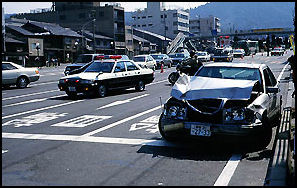
Good Websites and Sources: Good Photos at Japan-Photo Archive Auto-Related Stuff japan-photo.de , Bus-Related Stuff japan-photo.de and Filling Stations japan-photo.de ; U.S. Embassy on Driving in Japan tokyo.usembassy.gov ; Getting a Japanese Driver’s License globalcompassion.com/driving ; “Why I Hate Driving in Japan” japantoday.com/category/commentary ; Association for Safe International Road Travel: www.asirt.org Driving FAQs ajet.net/modules/articles ;
Japanese Motoring History st.rim.or.jp ;
Japan Shuffle, a blog with info on cars japanshuffle.blogspot.com ; Statistical Handbook of Japan Traffic Accidents Section stat.go.jp/english/data/handbook ; 2010 Edition stat.go.jp/english/data/nenkan ; News stat.go.jp ; Bus Travel Website: Learning About Kyoto Kyoto University
Sites for Expats Japanable site for Expats japanable.com ; That’s Japan thats-japan.com ; Orient Expat Japan orientexpat.com/japan-expat ; Kimi Information Center kimiwillbe.com ; Foreign & Commonwealth Office Report on Japan fco.gov.uk/en/travel-and-living-abroad ; Student Guide to Japan www2.jasso.go.jp/study ; Japan in Your Palm japaninyourpalm.com
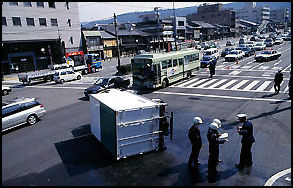
Links in this Website: BICYCLES AND MOTORCYCLES IN JAPAN Factsanddetails.com/Japan ; URBAN TRANSPORTATION IN JAPAN Factsanddetails.com/Japan ; TRAINS IN JAPAN Factsanddetails.com/Japan ; SHINKANSEN (JAPANESE BULLET TRAINS) Factsanddetails.com/Japan ; AUTOMOBILES AND DRIVING IN JAPAN Factsanddetails.com/Japan ; AUTOMOBILES ACCIDENTS IN JAPAN Factsanddetails.com/Japan ; HYBRIDS, FUEL CELLS AND ELECTRIC CARS IN JAPAN Factsanddetails.com/Japan ; JAPANESE AUTOMOBILE INDUSTRY Factsanddetails.com/Japan ; JAPANESE AUTOMOBILE COMPANIES Factsanddetails.com/Japan ; TOYOTA Factsanddetails.com/Japan ; TOYOTA PRODUCTION AND WORKERS Factsanddetails.com/Japan ; TOYOTA PROBLEMS Factsanddetails.com/Japan ;
TOYOTA CARS, RACING AND ROBOTS Factsanddetails.com/Japan ;
HONDA Factsanddetails.com/Japan ;
HONDA CARS, PLANES, ROBOTS AND RACING Factsanddetails.com/Japan ;
NISSAN Factsanddetails.com/Japan ;
INFRASTRUCTURE AND PUBLIC WORKS IN JAPAN Factsanddetails.com/Japan
Reasons for Fewer Automobile Accidents in Japan

Honda air bag design The decline in automobile accidents has been attributed to raised public awareness about drunk driving, stiffer penalties for traffic law violations, safer driving, a rise in the number of people using seat belts, improvements in life-saving technology, and fewer accident caused by speeding. There has been a marked decrease in the number of accidents involving drunk drivers but an increase in the ones involving elderly drivers. The number deaths caused by drunk driving dropped 29.8 percent in 2007 from the previous year to 430.
The Fukuoka accident (See Below) prompted the revision of the Road Traffic Law in September 2007 to penalize those who sold or offered alcohol to drunk drivers, effectively involving not only drunks drivers but the people who assisted the drivers in getting drunk.
The number of drunk accidents was nearly halved between 2005 and 2007 while the number of arrests for drunk driving remained about the same. In 2005 there were 13,875 drunk driving accidents, In 2007 there were 7,558. The numbers also dropped markedly in 2008. This was attributed to laws that require backseat drivers t wear seat belts, and tougher penalties for people who break the rules
There has also been campaigns oriented towards older drivers, including one that required older drivers to have a large sticker on their car so everyone can see they are an older driver. Drivers 75 and older who renew their license are now required to take a cognitive test. Iyf the score low on the test and have been caught violating a traffic rule in the previous year they are required to undergo a tests by medical specialists who determines whether they are competent to drive.
Eight Ferraris, Lamborghini in Million-dollar Car Crash
Douglas Stanglin wrote in USA TODAY: Eight Ferraris, three Mercedes-Benzes and a Lamborghini were involved in a 14-vehicle pileup on a Japanese freeway that could easily cost more than $1 million, the Daily Yomiuri reports. Most of the luxury cars were traveling in a convoy to a gathering of sports car enthusiasts in nearby Hiroshima, the Associated Press reports. The AP says the damage could easily top $1 million in a country where even a used Ferrari can fetch $100,000. The Japanese media put the bill as high as $3.8 million, AFP reports. [Source: Douglas Stanglin, USA TODAY, December 5, 2011]
“Ten people were hospitalized in the midmorning pileup on the Chugoku Expressway in Yamaguchi Prefecture, according to police.Police say they believe one of the Ferraris tried to change lanes, hit the median barrier and spun across the freeway. The other cars crashed while trying to avoid hitting the first car, the newspaper says. By the way, the AFP reports that a Toyota Prius was also banged up in the ordeal.
Serious Car Accidents in Japan
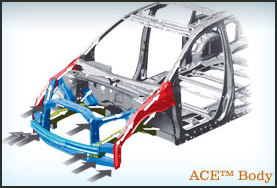
Honda's safe car body design In the early 2000s there were a number of serious highway accidents involving trucks. The accidents were blamed mainly on driver fatigue, economic hard times and deregulations of the trucking industry. Several of the truck drivers involved in the accidents fell asleep at the wheel after driving for long periods of time with little or no sleep. One driver in an accident that killed four and injured 12 had no memory of driving for 45 kilometers before the accident and worked both days and nights. In July 2004, the tire on truck carrying steel blew out, causing the truck to lose control and crush a passenger car, killing seven people.
In February 2006, six people were hurt in a 37-vehicle pileup on the Sanyo Expressway near Hiroshima in snowy conditions. The cause of the accidents was a small truck that skidded out control while passing a big truck, forcing the truck to crash into a guardrail.
In February 2006, 31 people were hurt in a 61-vehicle pile-up during snowy weather on the Hokuriku Expressway in Imizu in Toyama Prefecture. The accidents occurred on curving downward slope section of the highway.
In October 2008, a man was hit by a van at an intersection in Osaka and dragged for three kilometers before he was released. Th victim died from massive back and head injuries. The incident occurred at 4:14am. Witnesses said the van ran 20 red lights ad zigzagged back and forth between lanes, trying to shake the victim, who was found by police by following his blood stains on the road. There was no evidence of braking. It is believed that if the driver stopped and called for an ambulance immediately after the man was hit the man would be alive. Because the driver dragged the man, the police want to charge him with murder.
Drunk Driving in Japan
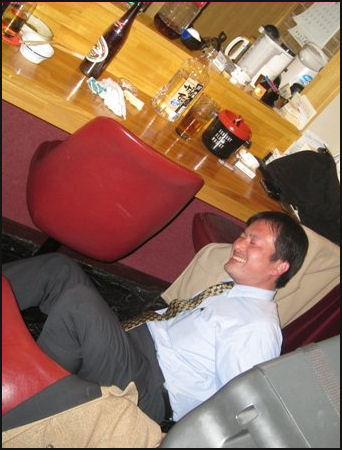
drunk salaryman Men convicted of drunk driving are sometimes sent to special prisons where they are not permitted to speak during the meals and live in tiny cells or barracks, and make soy paste and other products. The average sentence is around 11 months.
In June 2002 the maximum fine for drunk driving was increased from ¥100,000 to ¥500,000. After the change the number of drunk driving accidents decreased significantly and the number of deaths linked with drunk driving fell from 1,191 in 2001 to 780 in 2003.
Accidents and deaths involving drunk drivers were given wide coverage in both the print and on television after the Fukuoka accident (See Below). Fans that attended the concerts of popular pop singers and parked in facilities for the concert hall were required to undergo a breath-test before being allowed to drive. Displays of the new Beaujolais were accompanied by large signs warning about drunk driving and underage drinking. Checkpoints were set up around entertainment districts nabbing dozens of drunk drivers. In one week-long campaign, 1,126 drunk drivers were nabbed, including one man who was stopped and then stopped again and arrested a few hours later.
In the battle against drunk driving local governments have fired employees who were caught driving drunk. A number of these dismissals were overturned by courts who ruled the punishments were “too harsh.”
Toyota, Nissan and other car companies are experimenting with Breathalyzer devices that won’t let a driver start his car until he passes the test. They have developed sensors that detect blood-alcohol levels in the driver palms; a system that detects erratic movements through the steering wheel; and use a camera to check if the pupils are focused. If something wrong is detected the car slows down and come to a stop. The system is expected to be ready in 2009.
Drunk Driving Accidents in Japan
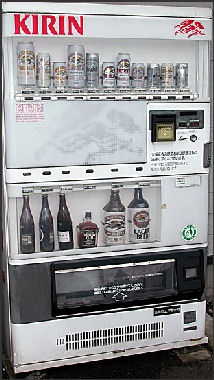
beer vending machine In 2006, a a major campaign against drunk driving began after an SUV carrying a couple and three young children was rear-ended in Fukuoka by a 22-year-old drunk driver and pushed off a bridge. The couple survived but the three children were killed. The drunk driver was a former government official. He fled the scene after the accident and drank a liter of water in an effort to hide the fact he was drinking.
In 2008, the driver in the Fukuoka accident was found guilty of dangerous driving causing death and was sentenced to 7 ½ years in prison, Prosecutors had sought a 25 year sentence. Later a hiogher court gave him a 20 year sentence. In another case around the same time a 34-year-old man who seriously injured a man, who was in a coma for months, while driving drunk was ordered to pay ¥303 million in compensation and sent to prison for two years and four months. .
In February 2006 a drunk driver in Aichi killed four people and injured two others. He was charged with negligence resulting in death and given a six year prison term.
In May 2005, a 26-year-old computer employee killed three high school students and injured more than 20 that were taking part in walkathon on a Sunday morning after falling asleep at wheel after seven hour of binge drinking at three pubs in the Sendai area.
In December 2007, a 50-year-old man was sentenced to 23 years in prison for killing three people in two accidents that occurred while he was driving drunk on the same night in Amagasaki in Hyogo Prefecture. First he killed a pedestrian and after driving about 800 meters further he collided with a taxi, killing two more people. The same months another driver was given 18 months in prison for killing four and injuring two after running a stop light while drunk.
People Dragged to Their Death by Cars
In 2008, twenty-two-year-old bar host and construction worker Keigo Yoshida, hit a 30-year-old man, Genentaro Suzuki, with a car as Suzuki was crossing an intersection in Osaka’s Umeda district at around 4:30am and traveled for three kilometers at an average speed of 50kph with Suzuki being dragged underneath the car.
Yoshida was charged with murder and negligence. He said after his arrest, “I was drunk and driving without a license, so I didn’t want to be arrested, and I desperately drove away. It’s true I killed him.” He said he fled the scene because he was worried about probation problems connected to a three-year suspended prison sentence for defrauding insurance companies of ¥6 million for intentionally causing a traffic accidents.
Yoshida said he had been waiting for a light to change. Immediately after putting the car in motion he hit Suzuki. “I saw somebody fall down in front of the car and then felt it roll over the person,” he said. “I immediately realized the person might die if I continued driving. But I wanted to get away as fast as I could.”
Yoshida was arrested after police found the small black station wagon he was driving in a parking lot and found scratches, blood stains and textile fibers on the car’s under carriage, The car’s owner, a construction company that employed Yoshida, said that Yoshida drove the vehicle for work but had not shown up for work since the accident. Police found Yoshida in a noddle ship near the host bar where he sometimes worked. He tried to run away but was fell down after a couple of meters and was caught.
In November 2008, a car hit a 16-year-old boy delivering newspapers at 2:50 am and dragged him five kilometers in Osaka Prefecture. The boy was found dead in a parking lot. The car that hit him was found near the body. The driver was very drunk. He said he remembered hitting a motorbike but continued driving because he didn’t want o get caught driving drunk.
In December 2008, a truck dragged another truck 20 kilometers after the two collided. The smaller truck, which rammed into the back of the larger truck, caught fire while being dragged, incinerating the driver that was in it.
Car Accident Scams in Japan
Several members of a family were arrested fro running a car accident scam in which the planted a parked car on a two lane road. When a car tried to pass it, going into the other lane, a Mercedes in other lane accelerated and crashed had on into the pass car. By the time police arrived the parked car disappeared and the owners of the Mercedes claimed they were hit and dreaded compensation. The people in the Mercedes and the parked car were in on the scam,. The family made more than 20 claims in a five year period and obtain ten of million of yen in claims.
Seven Die in Accident on Bus Bound for Tokyo Disneyland
In April 2012, the Yomiuri Shimbun reported: “Seven people were killed after a long-distance bus heading for Tokyo Disneyland crashed into a noise-blocking wall on the Kanetsu Expressway in Fujioka, Gunma Prefecture. According to local police and fire officials, 45 passengers were aboard the bus when it smashed into the wall on the left side of the expressway near Fujioka Junction at about 4:40 a.m. Thirteen passengers were severely injured, and another 25 suffered minor injuries. [Source: Yomiuri Shimbun, April 30, 2012]
“With a noise-blocking wall on the expressway slicing down the middle of the bus, the vehicle came to rest with its left side outside the wall. Many of those who died were seated on the left side. Some of the windows on the right side were damaged, and glass fragments were scattered around the site. After the crash, passengers were trapped inside the bus as the windows and doors could not be opened. Rescue workers had to smash several windows to help the passengers by pulling them out one by one, according to another passenger's acquaintance who visited her at the hospital. The visitor said: "I was stunned when I first saw her face covered with blood from a cut on her head. But I was relieved to see she was conscious.”
“An inspection by police concluded that the bus first hit a guardrail on its left while making a gentle left-hand turn, and then its left front crashed into the 2.9-meter-high wall. The wall sliced through about 10.5 meters of the 12-meter-long bus.A senior officer of the Gunma prefectural police said the bus seemed to lurch to the left after impact, a sudden movement that compounded the damage inside the vehicle.The first five or six seats on the left side were wrecked beyond recognition. Many of the deaths occurred in this section. [Source: Yomiuri Shimbun, April 30, 2012]
"About 10 minutes before the accident, the bus started weaving from side to side. As I was wondering if the driver was dozing, the bus crashed," a female passenger hospitalized in Fujioka told a 23-year-old male friend who was visiting her there. The man told the Yomiuri Shimbun the woman also described the left-hand side of the bus as wrecked, saying she was seated on the right side--the same as the driver--and only broke her nose. [Source: Yomiuri Shimbun, May 1, 2012]
“Yukari Kizawa of Kanazawa was aboard the bus with three family members. Her husband, Masahiro, was pronounced dead following the accident. Yukari called her parents from the crash site at about 5 a.m., roughly 20 minutes after the accident. "I had no idea what happened at the time of the crash as I was asleep," her brother-in-law, who rushed to the hospital, quoted her as saying. Many of the passengers were asleep when the bus crashed.
Driver 'Braked Often' and Fell Asleep Before Deadly Crash
Driver Kazan Kono told the Gunma prefectural police he fell asleep at the wheel, the police said. The police are investigating Kono, 43, on suspicion of negligent driving resulting in injury and death. Kono was also injured in the accident, the police said. The bus was operated by Rikuen-tai, a company based in Inzai, Chiba Prefecture. According to Rikuen-tai, the bus departed from Kanazawa at about 10 p.m. and was headed for Tokyo Disneyland in Urayasu, Chiba Prefecture. [Source: Yomiuri Shimbun, April 30, 2012]
“The number of drivers assigned to each bus is decided according to the distance to be traveled, the employee said. Only one driver has been assigned to trips shuttling from Chiba Prefecture to cities such as Kanazawa, Yamagata, Sendai, Nagoya and Niigata. The president has told drivers to take a 15-minute break every two hours and a 30-minute break every four hours, the employee said.
“Relatives of several passengers told the Yomiuri Shimbun the driver rested facedown in his seat during a break in the journey and suddenly braked several times just before the accident. Some passengers have said they were disturbed by how exhausted the driver appeared just before the bus plowed into the noise-blocking wall on the Kanetsu Expressway in Fujioka, Gunma Prefecture, about 6-1/2 hours after it left JR Kanazawa Station. [Source: Yomiuri Shimbun, May 2, 2012]
“Hikaru Makide, a 23-year-old Ishikawa prefectural official, was sitting in the front seat of the bus. She was alarmed by the apparent fatigue affecting the 43-year-old driver, Kazan Kono. "When I looked at the driver, he was often checking the satellite navigation system, and he slammed on the brakes several times. I was really worried," Makide, who was severely injured in the accident, reportedly told her father.
“Satoshi Korin, a 22-year-old senior student of Kanazawa Institute of Technology, was sitting on the right side near the back of the bus and was slightly injured. He told his mother the driver announced the bus would stop for a break at a rest area at about 4 a.m.--about 40 minutes before the accident. Although Korin was asleep and did not hear the announcement, he said other passengers were saying the driver's voice was unclear and hard to understand. He saw the driver facedown over the steering wheel during the break. "He seems to be really tired," Korin quoted another passenger as saying anxiously.
Fatigued Bus Drivers in Japan and New Limits on Their Driving
In July 2012, in response to the April 2012 bus crash that killed six people, new maximum nighttime driving distance rules went into affect for bus drivers, a change that is intended to increase bus safety but may result in higher fares and services being cut by operators feeling the financial squeeze. Under the new standard, the maximum distance driven by a single driver at night will be reduced from the current 670 kilometers to 400 kilometers. The new limit will require bus operators to assign replacement drivers for most routes, which until now, have been handled by one driver. As a result, bus operators will have to either reduce services due to a lack of drivers, or have the cost of hiring extra drivers reflected in fares. [Source: Yuki Tsuru and Yasushi Kaneko, Yomiuri Shimbun. July 17, 2012]
In May 2012, the Yomiuri Shimbun reported: “Several tour bus drivers have revealed that their companies often violate safety regulations for long-distance journeys. Many drivers interviewed by the Yomiuri said they have trouble concentrating because of extreme fatigue. "I've fallen asleep while driving," said one driver, aged in his 30s, who appeared tired. "I've also been woken up by passengers when I overslept during breaks." [Source: Yomiuri Shimbun, May 4, 2012]
“The driver told the Yomiuri Shimbun he was driving a bus from Tokyo at 10 p.m. that was scheduled to arrive in Osaka at about 8 a.m. the following day. He would drive the return leg at 10 p.m. that night. During the day, the driver could rest at a discount hotel, which was booked by the travel agency that ordered the bus service. But while he was meant to be able to rest in his room for about 12 hours between the trips, the driver would sometimes be unable to check in until noon, or be forced to check out at about 3 p.m."When this happens I would have to kill time on the bus, so I wouldn't feel refreshed," the driver said.
“Under the Land, Infrastructure, Transport and Tourism Ministry's safety guideline, drivers of tour buses must be given at least eight hours of rest after completing one journey. But, a former employee of another bus company said, "I could rest for only three or four hours until the start of my next journey after passengers disembarked, and I cleaned the bus and returned to my company." Drivers also said bus operations are sometimes unsupervised.
“Under the Road Transportation Law, bus operators must have at least one certified operation manager on duty.Operation managers must confirm the health conditions of drivers and provide them with written instructions about journeys. But a 54-year-old man who was an operation manager at a bus company in Saitama Prefecture until February said, "I never performed alcohol tests and health checks or confirmed routes before drivers started work."He also said the company used the names of operation managers from other companies and paid 30,000 yen per person to pretend two or more operation managers were present at work. Daily operation reports were also lax at the company. The former operation manager said if certain drivers could not have eight hours of rest because of work schedules, "I wrote down the names of other drivers.”
“Industry sources said these illegal practices have been growing as competition among bus companies intensifies. The law was revised in 2000 to allow new tour bus operators to obtain permission from authorities concerned instead of passing a national licensing system.Since then, the number of tour and chartered bus operators has doubled. The companies have cut labor costs as they compete with each other to obtain orders from travel agencies, the industry sources said.
Image Sources: 1) 2) 3) Honda 4) 5) Neil Duckett, accident pictures, Japan-Photo.de
Text Sources: New York Times, Washington Post, Los Angeles Times, Daily Yomiuri, Times of London, Japan National Tourist Organization (JNTO), National Geographic, The New Yorker, Time, Newsweek, Reuters, AP, Lonely Planet Guides, Compton’s Encyclopedia and various books and other publications.
Last updated July 2012
